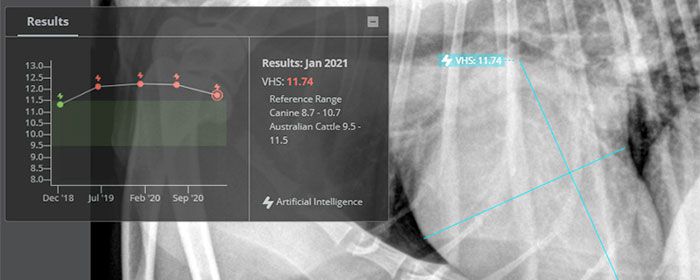IDEXX Web PACS Vertebral Heart Score Results and Trending Feature Can Help You Diagnose and Treat Heart Disease Faster

Do you wish someone would take over the mundane, time-consuming tasks you do on a daily basis so you can devote more time to what’s important? IDEXX hears you, and they are constantly working to develop efficiencies that will help you diagnose and treat disease faster. Vertebral heart score (VHS), a measurement validated by board-certified IDEXX cardiologists, allows veterinarians to objectively evaluate a dog’s heart size to determine whether it is larger than normal. Historically, this has involved manually measuring the heart’s longest and widest points on a radiograph, comparing these measurements to the vertebral column, and counting the total number of vertebrae that correspond to the measurements. The VHS is then compared to a normal range to determine whether the heart is enlarged. Calculating a dog’s VHS is tedious and time-consuming, and it is often repeated many times per patient to track the heart’s size over time.
Let IDEXX Web PACS VHS results and trending feature do the work for you
IDEXX recently introduced a new feature to its IDEXX Web PACS Software—a fully integrated diagnostic imaging platform for optimal sharing, consulting, and storing—that simplifies VHS measurement and tracking for veterinarians. Using artificial intelligence (AI), information from thousands of images was leveraged to train the software to identify the correct measurement points. After taking a lateral thoracic radiograph, a user can activate the VHS feature with a mouse click. The software applies measurement lines to the long and short heart axes, indexes these to the average length of the T4–T9 vertebrae, and calculates the VHS. An accurate measurement is generated by the time you can pull out your ruler. The measurement is compared to an appropriate breed-specific or general canine reference interval to determine whether the VHS is within normal range for the patient, and the point is plotted on the trending line.
How IDEXX Web PACS VHS results and trending feature helps you and your patients
The new IDEXX Web PACS VHS results and trending feature benefits you—and your patients—in multiple ways.
#1: The VHS feature saves you precious time
This AI-driven innovation does the work so you can quickly pick up on life-threatening heart disease and focus on treating your patients, instead of performing repetitive measurements. The software even compares each VHS to a breed-specific chart of normal ranges, since a bulldog’s normal heart is a different size and shape than a beagle’s, so you don’t have to search the internet or flip through books to locate normal values.
#2: You can pick up on heart enlargement, and begin treatment, sooner
When you detect a heart murmur, a thoracic radiograph is the next diagnostic step. With the IDEXX Web PACS VHS feature, you will know within seconds, and with high accuracy, whether your patient has heart enlargement. After calculating the VHS, the software automatically plots the data point on a graph that includes a shaded area corresponding to the breed’s normal VHS range. Data points that fall within the normal range appear green, and those that fall above the range appear red. You can tell at a glance whether your patient’s VHS indicates heart disease, so you can determine the most appropriate next steps.
#3: VHS trending helps you efficiently monitor heart disease over time
Heart disease progresses over time, making the VHS tracking element particularly important. When you take multiple radiographs and VHS measurements over time, the IDEXX Web PACS VHS feature clearly plots each data point on a graph. You can easily appreciate progressive heart enlargement, which indicates worsening disease, stable heart disease, or a heart that becomes smaller in response to treatment.
#4: VHS trending helps you monitor MMVD progression
Approximately 70% of dogs with heart disease have myxomatous mitral valve disease (MMVD), making it the most common heart condition in dogs.1 Early disease causes only a murmur, but heart enlargement develops as the disease progresses. Early intervention and treatment are imperative to show or prevent MMVD from progressing to heart failure. Each individual patient’s heart disease will progress at a different rate, so monitoring VHS allows you to effectively track rate of progression of each individual’s heart disease to determine when it is best to begin, or alter, treatment.
The IDEXX Web PACS VHS results and trending feature can help you ditch your ruler and books, save more time, and diagnose heart disease faster. Want to learn more? Sign up for a free demo to discover the various ways the IDEXX Web PACS platform can benefit your practice.
Reference:
- Parker HG, Kilroy-Glynn P. Myxomatous mitral valve disease in dogs: does size matter? J Vet Cardiol. 2012;14(1):19–29. doi:10.1016/j.jvc.2012.01.006